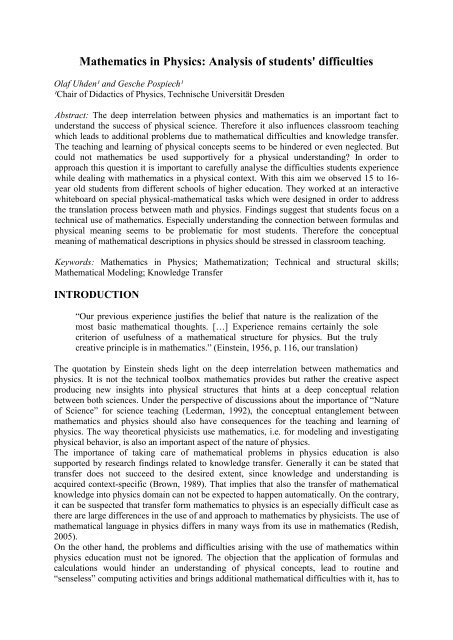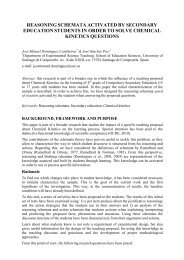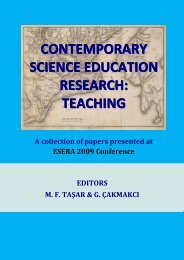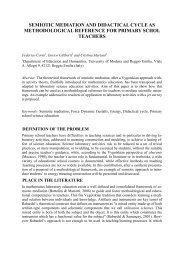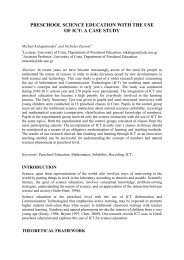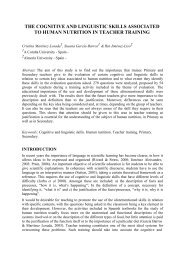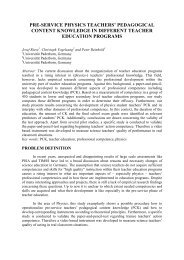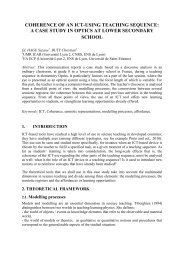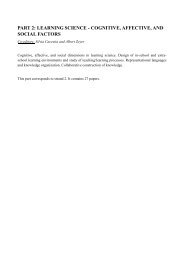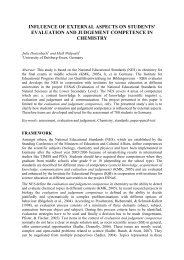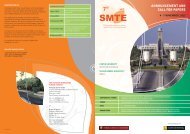Mathematics in physics: analysis of students' difficulties - ESERA
Mathematics in physics: analysis of students' difficulties - ESERA
Mathematics in physics: analysis of students' difficulties - ESERA
Create successful ePaper yourself
Turn your PDF publications into a flip-book with our unique Google optimized e-Paper software.
<strong>Mathematics</strong> <strong>in</strong> Physics: Analysis <strong>of</strong> <strong>students'</strong> <strong>difficulties</strong><br />
Olaf Uhden¹ and Gesche Pospiech¹<br />
¹Chair <strong>of</strong> Didactics <strong>of</strong> Physics, Technische Universität Dresden<br />
Abstract: The deep <strong>in</strong>terrelation between <strong>physics</strong> and mathematics is an important fact to<br />
understand the success <strong>of</strong> physical science. Therefore it also <strong>in</strong>fluences classroom teach<strong>in</strong>g<br />
which leads to additional problems due to mathematical <strong>difficulties</strong> and knowledge transfer.<br />
The teach<strong>in</strong>g and learn<strong>in</strong>g <strong>of</strong> physical concepts seems to be h<strong>in</strong>dered or even neglected. But<br />
could not mathematics be used supportively for a physical understand<strong>in</strong>g? In order to<br />
approach this question it is important to carefully analyse the <strong>difficulties</strong> students experience<br />
while deal<strong>in</strong>g with mathematics <strong>in</strong> a physical context. With this aim we observed 15 to 16-<br />
year old students from different schools <strong>of</strong> higher education. They worked at an <strong>in</strong>teractive<br />
whiteboard on special physical-mathematical tasks which were designed <strong>in</strong> order to address<br />
the translation process between math and <strong>physics</strong>. F<strong>in</strong>d<strong>in</strong>gs suggest that students focus on a<br />
technical use <strong>of</strong> mathematics. Especially understand<strong>in</strong>g the connection between formulas and<br />
physical mean<strong>in</strong>g seems to be problematic for most students. Therefore the conceptual<br />
mean<strong>in</strong>g <strong>of</strong> mathematical descriptions <strong>in</strong> <strong>physics</strong> should be stressed <strong>in</strong> classroom teach<strong>in</strong>g.<br />
Keywords: <strong>Mathematics</strong> <strong>in</strong> Physics; Mathematization; Technical and structural skills;<br />
Mathematical Model<strong>in</strong>g; Knowledge Transfer<br />
INTRODUCTION<br />
“Our previous experience justifies the belief that nature is the realization <strong>of</strong> the<br />
most basic mathematical thoughts. […] Experience rema<strong>in</strong>s certa<strong>in</strong>ly the sole<br />
criterion <strong>of</strong> usefulness <strong>of</strong> a mathematical structure for <strong>physics</strong>. But the truly<br />
creative pr<strong>in</strong>ciple is <strong>in</strong> mathematics.” (E<strong>in</strong>ste<strong>in</strong>, 1956, p. 116, our translation)<br />
The quotation by E<strong>in</strong>ste<strong>in</strong> sheds light on the deep <strong>in</strong>terrelation between mathematics and<br />
<strong>physics</strong>. It is not the technical toolbox mathematics provides but rather the creative aspect<br />
produc<strong>in</strong>g new <strong>in</strong>sights <strong>in</strong>to physical structures that h<strong>in</strong>ts at a deep conceptual relation<br />
between both sciences. Under the perspective <strong>of</strong> discussions about the importance <strong>of</strong> “Nature<br />
<strong>of</strong> Science” for science teach<strong>in</strong>g (Lederman, 1992), the conceptual entanglement between<br />
mathematics and <strong>physics</strong> should also have consequences for the teach<strong>in</strong>g and learn<strong>in</strong>g <strong>of</strong><br />
<strong>physics</strong>. The way theoretical physicists use mathematics, i.e. for model<strong>in</strong>g and <strong>in</strong>vestigat<strong>in</strong>g<br />
physical behavior, is also an important aspect <strong>of</strong> the nature <strong>of</strong> <strong>physics</strong>.<br />
The importance <strong>of</strong> tak<strong>in</strong>g care <strong>of</strong> mathematical problems <strong>in</strong> <strong>physics</strong> education is also<br />
supported by research f<strong>in</strong>d<strong>in</strong>gs related to knowledge transfer. Generally it can be stated that<br />
transfer does not succeed to the desired extent, s<strong>in</strong>ce knowledge and understand<strong>in</strong>g is<br />
acquired context-specific (Brown, 1989). That implies that also the transfer <strong>of</strong> mathematical<br />
knowledge <strong>in</strong>to <strong>physics</strong> doma<strong>in</strong> can not be expected to happen automatically. On the contrary,<br />
it can be suspected that transfer form mathematics to <strong>physics</strong> is an especially difficult case as<br />
there are large differences <strong>in</strong> the use <strong>of</strong> and approach to mathematics by physicists. The use <strong>of</strong><br />
mathematical language <strong>in</strong> <strong>physics</strong> differs <strong>in</strong> many ways from its use <strong>in</strong> mathematics (Redish,<br />
2005).<br />
On the other hand, the problems and <strong>difficulties</strong> aris<strong>in</strong>g with the use <strong>of</strong> mathematics with<strong>in</strong><br />
<strong>physics</strong> education must not be ignored. The objection that the application <strong>of</strong> formulas and<br />
calculations would h<strong>in</strong>der an understand<strong>in</strong>g <strong>of</strong> physical concepts, lead to rout<strong>in</strong>e and<br />
“senseless” comput<strong>in</strong>g activities and br<strong>in</strong>gs additional mathematical <strong>difficulties</strong> with it, has to
e taken seriously. However, one can assume that these problems stem <strong>in</strong> large part on the<br />
way <strong>in</strong> which mathematics is <strong>in</strong>volved <strong>in</strong> <strong>physics</strong> teach<strong>in</strong>g. Already Richard Skemp, a pioneer<br />
<strong>in</strong> mathematics education research, po<strong>in</strong>ted out the difference between <strong>in</strong>strumental and<br />
relational understand<strong>in</strong>g (Skemp, 1976). By focus<strong>in</strong>g on <strong>in</strong>strumental skills like rote<br />
manipulations and learn<strong>in</strong>g rules, it is not possible to achieve a deep (relational)<br />
understand<strong>in</strong>g <strong>of</strong> mathematical concepts. But especially for knowledge transfer a relational<br />
understand<strong>in</strong>g is <strong>in</strong>dispensable. Therefore, it is particularly important <strong>in</strong> <strong>physics</strong> classes to<br />
stress this k<strong>in</strong>d <strong>of</strong> understand<strong>in</strong>g <strong>of</strong> the relationship between physical behavior and<br />
mathematics.<br />
THEORETICAL FRAMEWORK<br />
A deep <strong>analysis</strong> <strong>of</strong> the role <strong>of</strong> mathematics <strong>in</strong> <strong>physics</strong> leads to the dist<strong>in</strong>ction <strong>in</strong>to a technical<br />
and a structural role. Whereas the technical role describes the tool-like use <strong>of</strong> mathematics<br />
(e.g. calculat<strong>in</strong>g numbers), the structural role represents the close connection between <strong>physics</strong><br />
and mathematics and their structural entanglement (e.g. the possibility to predict new <strong>physics</strong><br />
from mathematical equations). In classroom situations the technical skills seem to be<br />
dom<strong>in</strong>ant, although the structural skills – e.g. mathematiz<strong>in</strong>g and <strong>in</strong>terpret<strong>in</strong>g – allow a<br />
mean<strong>in</strong>gful use <strong>of</strong> mathematics. Moreover, a focus on the structural role <strong>of</strong> mathematics<br />
would be more <strong>in</strong> l<strong>in</strong>e with the nature <strong>of</strong> <strong>physics</strong> than the current <strong>in</strong>strumental use <strong>of</strong><br />
mathematics (for a deep <strong>in</strong>vestigation <strong>of</strong> this issue and the derivation <strong>of</strong> a correspond<strong>in</strong>g<br />
didactical model, see Uhden, Karam, Pietrocola & Pospiech, 2011).<br />
A shift <strong>in</strong> the teach<strong>in</strong>g practice towards the structural skills, and thereby towards the<br />
translation between <strong>physics</strong> and mathematics, requires the consideration <strong>of</strong> relevant didactic<br />
concepts. With the translation to and from mathematics the so called “Grundvorstellungen”<br />
(vom H<strong>of</strong>e, 1992) – a theoretical concept used <strong>in</strong> mathematics education research to describe<br />
the translation between ideas or mean<strong>in</strong>g and mathematical operations – emerge as they<br />
mediate between the mathematical and physical world. The term “Grundvorstellungen” might<br />
be best translated as “basic ideas” or “mental models”. It refers to mathematical objects (i.e.<br />
mathematical operations, symbols etc.) and the ideas and conceptions connected to them. For<br />
example, a basic idea <strong>of</strong> “addition” can be understood as a sum <strong>of</strong> contributions, i.e. the<br />
operation <strong>of</strong> add<strong>in</strong>g two amounts to get the whole amount as a result. On the other hand, one<br />
can th<strong>in</strong>k <strong>of</strong> “addition” as chang<strong>in</strong>g an <strong>in</strong>itial state to a f<strong>in</strong>al state – as it is the case for<br />
describ<strong>in</strong>g changes <strong>in</strong> temperature. Obviously there is not only one correct basic idea <strong>of</strong> a<br />
mathematical operation. Rather it is important to activate the basic idea correspond<strong>in</strong>g to the<br />
specific problem one deals with. Therefore one needs to have more than one basic idea<br />
available for activation. Enabl<strong>in</strong>g a flexible use requires experience and knowledge based on<br />
comprehension or, <strong>in</strong> other words, a relational understand<strong>in</strong>g.<br />
In the physical context these “Grundvorstellungen” have to be connected to an understand<strong>in</strong>g<br />
<strong>of</strong> the physical concepts and be activated <strong>in</strong> accordance to the physical situation. Sher<strong>in</strong><br />
(2001) <strong>in</strong>vestigated the mean<strong>in</strong>gs college students assign to formulas and classified them as so<br />
called “symbolic forms”. A symbolic form is an entity <strong>in</strong> a formula which is associated with a<br />
correspond<strong>in</strong>g physical behavior, e.g. a fraction stroke with a variable <strong>in</strong> the denom<strong>in</strong>ator<br />
means that the result<strong>in</strong>g behavior is <strong>in</strong>versely proportional to this variable. But as it is the case<br />
with the “Grundvorstellungen”, there also exist more symbolic forms for one formal structure.<br />
Sher<strong>in</strong> claims for ongo<strong>in</strong>g research <strong>in</strong> the same direction with students at a younger age (i.e.<br />
high school and secondary school) and for teach<strong>in</strong>g strategies which strengthen the use <strong>of</strong><br />
symbolic forms. Also an <strong>in</strong>-depth <strong>analysis</strong> <strong>of</strong> its <strong>in</strong>terplay with <strong>students'</strong> strategies and<br />
<strong>difficulties</strong> is still ow<strong>in</strong>g.
RESEARCH DESIGN<br />
The del<strong>in</strong>eated argumentation leads to the ma<strong>in</strong> research question which needs to be answered<br />
by a qualitative study: What k<strong>in</strong>d <strong>of</strong> <strong>difficulties</strong> do students have with mathematical reason<strong>in</strong>g<br />
<strong>in</strong> <strong>physics</strong>?<br />
For animat<strong>in</strong>g the students to use structural skills and for <strong>in</strong>vestigat<strong>in</strong>g the result<strong>in</strong>g<br />
<strong>difficulties</strong> students experience thereby, we developed special mathematical <strong>physics</strong> tasks <strong>in</strong><br />
order to address different aspects <strong>of</strong> translat<strong>in</strong>g between <strong>physics</strong> and mathematics. By<br />
work<strong>in</strong>g with these tasks the students are challenged to actively carry out the translation and<br />
to establish the connection between mathematics and <strong>physics</strong> not on a calculational but on a<br />
mean<strong>in</strong>gful basis. More specifically the tasks conta<strong>in</strong> amongst other aspects<br />
the creation <strong>of</strong> a formula on the basis <strong>of</strong> physical reason<strong>in</strong>g<br />
the <strong>in</strong>terpretation <strong>of</strong> the special cases <strong>of</strong> a formula<br />
to draw conclusions based on a formula for physical behavior<br />
expla<strong>in</strong><strong>in</strong>g the mean<strong>in</strong>g <strong>of</strong> a formula<br />
The theoretical assumptions about the nature <strong>of</strong> the connection between <strong>physics</strong> and<br />
mathematics, as exposed <strong>in</strong> the model by Uhden et al. (2011), guided the construction <strong>of</strong> the<br />
tasks. The degree <strong>of</strong> difficulty was validated by the observations made <strong>in</strong> the pilot study<br />
which also gave h<strong>in</strong>ts for improvements and additional ideas. The physical topic is mechanics<br />
due to the fact that this is the topic with the highest degree <strong>of</strong> mathematics <strong>in</strong>volved <strong>in</strong><br />
secondary school.<br />
In total 30 students from different schools <strong>of</strong> higher education <strong>in</strong> Germany (“Gymnasium”)<br />
were <strong>in</strong>vited to work on the tasks. The students are from class level 9 and 10 – i.e. 15 to 16-<br />
years old – and their school grades <strong>in</strong>dicate a selection <strong>of</strong> ma<strong>in</strong>ly good students, but with<br />
more satisfactory grades than very good ones.<br />
As the students worked <strong>in</strong> pairs at an <strong>in</strong>teractive whiteboard we were able to conduct the<br />
observation without a video camera because the whiteboard provides the possibility to record<br />
the speech and writ<strong>in</strong>gs simultaneously. The students were requested to discuss the problems<br />
with each other and get a jo<strong>in</strong>t solution <strong>in</strong> order to animate them to speak aloud and express<br />
their ideas and thoughts. This makes it possible to follow their l<strong>in</strong>es <strong>of</strong> reason<strong>in</strong>g and thought<br />
processes to some degree. The recorded speech was transcribed and placed <strong>in</strong> relation to the<br />
writ<strong>in</strong>gs. The transcripts were then evaluated accord<strong>in</strong>g to the framework <strong>of</strong> qualitative<br />
content <strong>analysis</strong> (Mayr<strong>in</strong>g, 2008).<br />
RESULTS<br />
The observed <strong>difficulties</strong> were categorized along 4 ma<strong>in</strong> categories (which were each divided<br />
<strong>in</strong>to subcategories):<br />
Mathematical understand<strong>in</strong>g<br />
Superficial translation<br />
Connection between formula and mean<strong>in</strong>g<br />
Interference with <strong>in</strong>tuitive notions<br />
The category “Mathematical understand<strong>in</strong>g” refers to pure mathematical <strong>difficulties</strong> where no<br />
explicit connection to <strong>physics</strong> can be observed. That can perta<strong>in</strong> to problems with<br />
mathematical reason<strong>in</strong>g or to the already mentioned basic ideas. Nevertheless, these k<strong>in</strong>d <strong>of</strong><br />
<strong>difficulties</strong> have <strong>in</strong>fluences on the physical argumentation: If an <strong>in</strong>crease <strong>in</strong> the denom<strong>in</strong>ator
leads to an <strong>in</strong>crease <strong>of</strong> the whole fraction, the <strong>in</strong>terpreted physical behavior will also be<br />
wrong.<br />
The category “Superficial translation” is related to a strategic aspect. The established<br />
subcategories <strong>in</strong>dicate that the connection between <strong>physics</strong> and mathematics is guided by<br />
superficial criteria. For example, for many students the association <strong>of</strong> formulas and units<br />
seems to be based on rote learn<strong>in</strong>g and the formula v=s/t is used once velocity is mentioned,<br />
no matter what physical circumstances are present.<br />
The “Connection between formula and mean<strong>in</strong>g” is an essential category that is <strong>in</strong> close<br />
correspondence to the mentioned symbolic forms (Sher<strong>in</strong>, 2001). The classified <strong>difficulties</strong><br />
demonstrate a severe lack <strong>of</strong> understand<strong>in</strong>g <strong>of</strong> equations and its related physical mean<strong>in</strong>g. For<br />
example, the role <strong>of</strong> physical magnitudes as be<strong>in</strong>g a function, parameter, variable or constant<br />
seems to be confused or disregarded by some students. That led to discuss<strong>in</strong>g the <strong>in</strong>fluence <strong>of</strong><br />
a function on a parameter with the result <strong>of</strong> confusion.<br />
The category “Interference with <strong>in</strong>tuitive notions” <strong>in</strong>cludes that students reject an actually<br />
successful connection between physical and mathematical argumentation due to implications<br />
that are <strong>in</strong> contradiction to their <strong>in</strong>tuitive notions. If, for <strong>in</strong>stance, the physical description is<br />
not understood as an idealization, the (idealized) mathematical results are considered as<br />
unrealistic, lead<strong>in</strong>g to a shortened <strong>in</strong>terpretation <strong>of</strong> the results.<br />
IMPLICATIONS<br />
The outl<strong>in</strong>ed <strong>difficulties</strong> are a plea for a change from the technical to the structural<br />
mathematical skills <strong>in</strong> <strong>physics</strong> teach<strong>in</strong>g and learn<strong>in</strong>g. Especially the observed superficial<br />
translation seems to be cultivated by a focus on a technical use <strong>of</strong> mathematics. And also the<br />
mathematical understand<strong>in</strong>g can be assisted by teach<strong>in</strong>g structural skills without delegat<strong>in</strong>g<br />
this task to mathematics education.<br />
Furthermore, the categorized <strong>difficulties</strong> with the translation between formula and physical<br />
mean<strong>in</strong>g <strong>of</strong>fer the possibility to be addressed explicitly <strong>in</strong> the classroom <strong>in</strong> consistence with<br />
the symbolic forms. That could help build<strong>in</strong>g the foundations for a mean<strong>in</strong>gful use <strong>of</strong><br />
mathematics <strong>in</strong> <strong>physics</strong> teach<strong>in</strong>g. Tasks that address the connection between <strong>physics</strong> and<br />
mathematics, as well as a general qualitatively oriented use <strong>of</strong> mathematical structures, are<br />
further possibilities to stress and support the understand<strong>in</strong>g <strong>of</strong> structural skills.<br />
Acknowledgements<br />
Thanks to the European Social Fund (ESF) and to the Free State <strong>of</strong> Saxony for the f<strong>in</strong>ancial<br />
fund<strong>in</strong>g <strong>of</strong> this PhD-project.<br />
REFERENCES<br />
Brown, J. S., Coll<strong>in</strong>s, A., & Duguid, P. (1989). Situated Cognition and the Culture <strong>of</strong><br />
Learn<strong>in</strong>g. Education Researcher, 18(1), 32 – 42<br />
E<strong>in</strong>ste<strong>in</strong>, A. (1956). Me<strong>in</strong> Weltbild. West-Berl<strong>in</strong>: Ullste<strong>in</strong><br />
Mayr<strong>in</strong>g, P. (2008). Qualitative Inhaltsanalyse. We<strong>in</strong>heim: Beltz<br />
H<strong>of</strong>e, R. vom (1992). Grundvorstellungen mathematischer Inhalte als didaktisches Modell.<br />
Journal für Mathematikdidaktik, 13 (4), 345-364<br />
Lederman, N.G. (1992). Student's and teacher's conceptions <strong>of</strong> the nature <strong>of</strong> science: A review<br />
<strong>of</strong> the research. Journal <strong>of</strong> Research <strong>in</strong> Science Teach<strong>in</strong>g, 29(4), 331-359
Redish, E. F. (2006). Problem solv<strong>in</strong>g and the use <strong>of</strong> math <strong>in</strong> <strong>physics</strong> courses. Proceed<strong>in</strong>gs <strong>of</strong><br />
the Conference, World View on Physics Education <strong>in</strong> 2005: Focus<strong>in</strong>g on Change, Delhi,<br />
India, August 21–26.<br />
Sher<strong>in</strong>, B. (2001). How students understand <strong>physics</strong> equations. Cognition and Instruction, 19<br />
(4), 479-541<br />
Skemp, R. R. (1976). Relational understand<strong>in</strong>g and <strong>in</strong>strumental understand<strong>in</strong>g. <strong>Mathematics</strong><br />
Teacher, 77, 20-26<br />
Uhden, O., Karam, R., Pietrocola, M., & Pospiech, G. (2011). Modell<strong>in</strong>g Mathematical<br />
Reason<strong>in</strong>g <strong>in</strong> Physics Education. Science & Education, doi: 10.1007/s11191-011-9396-6,<br />
<strong>in</strong> press


